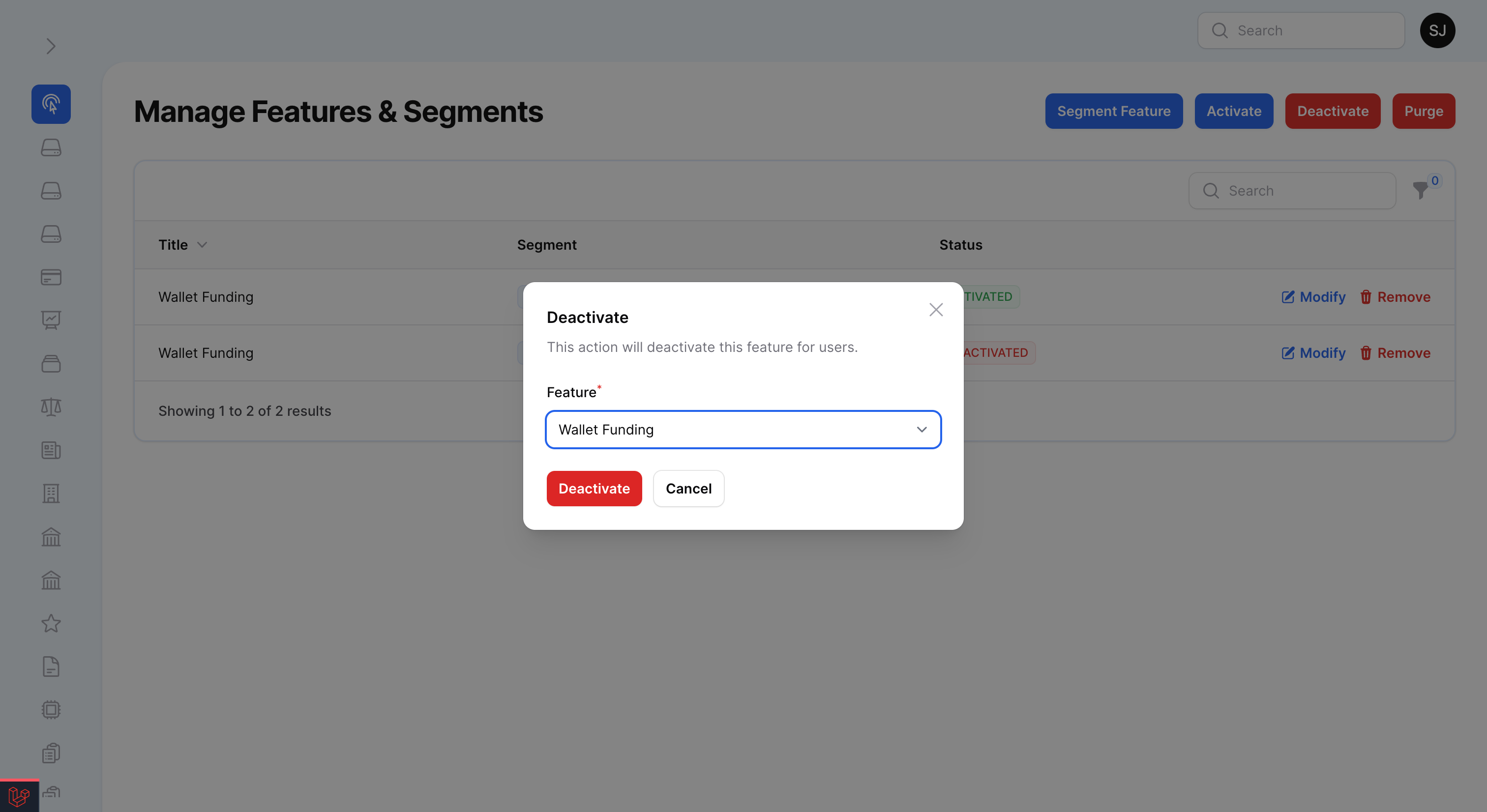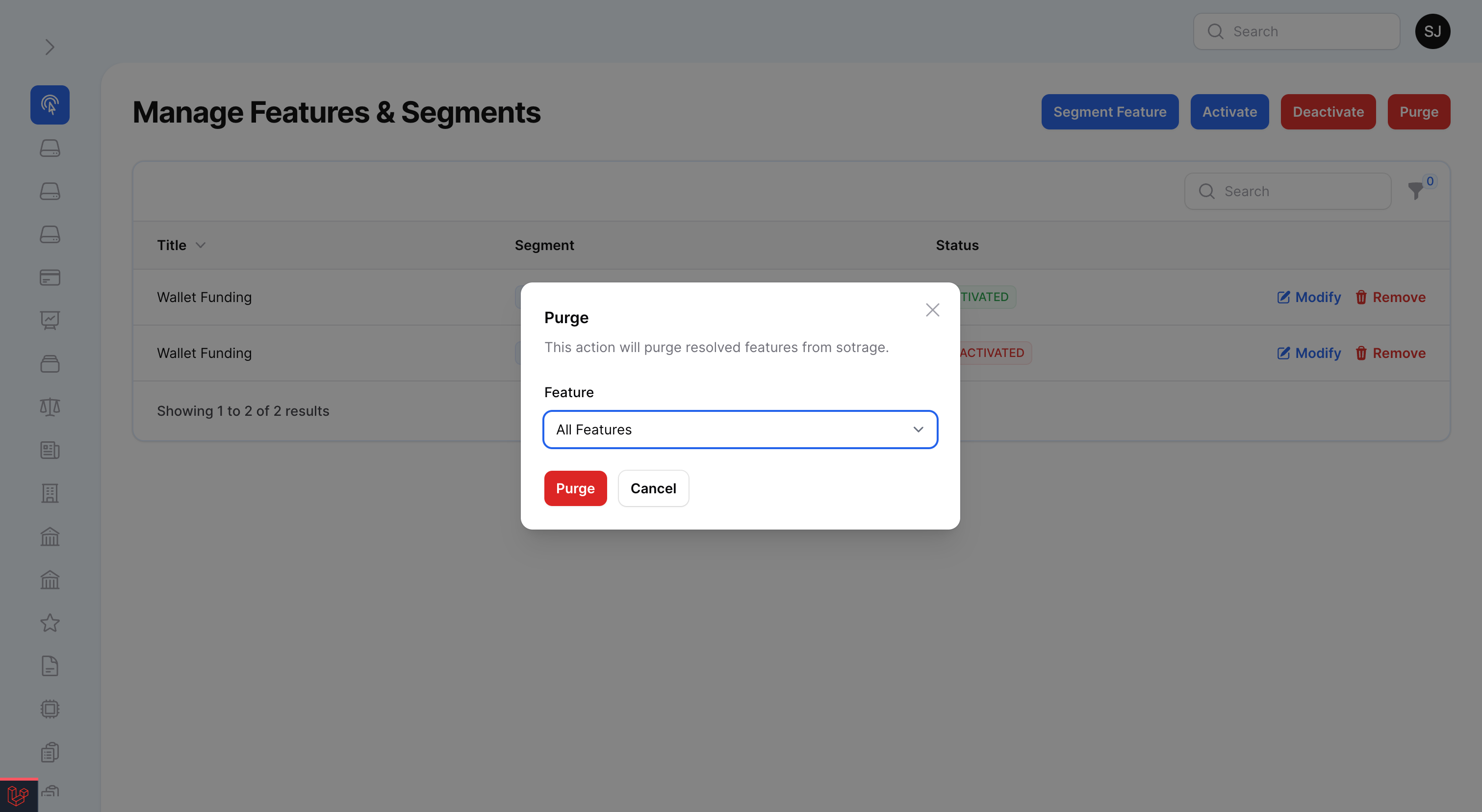stephenjude / filament-feature-flags
Filament implementation of feature flags and segmentation with Laravel Pennant.
Installs: 72 729
Dependents: 0
Suggesters: 0
Security: 0
Stars: 118
Watchers: 1
Forks: 22
Open Issues: 3
pkg:composer/stephenjude/filament-feature-flags
Requires
- php: ^8.3
- filament/filament: ^4.0
- laravel/pennant: ^1.10
- spatie/laravel-package-tools: ^1.14.0
Requires (Dev)
- laravel/pint: ^1.0
- nunomaduro/collision: ^7.8|^8.0
- orchestra/testbench: ^8.8|^10.0
- pestphp/pest: ^2.20|^3.7
- pestphp/pest-plugin-arch: ^2.0|^3.0
- pestphp/pest-plugin-laravel: ^2.0|^3.1
- pestphp/pest-plugin-livewire: ^2.1|^3.0
README
Filament Feature Flags
Filament implementation of feature flags and segmentation with Laravel Pennant.
- Apply features for a segment of users (i.e., by country or currency)
- Apply features for individual users (i.e., by email or ID)
- Apply features for all users
- Create custom feature segmentation
- Feature event handling (i.e., run code when a feature is activated/deactivated)
- UI to modify a segment of users
- Purge all resolved features from storage
Learn More
Installation
You can install the package via composer and publish and run the migrations with:
composer require stephenjude/filament-feature-flags php artisan vendor:publish --provider="Laravel\Pennant\PennantServiceProvider" php artisan vendor:publish --provider="Stephenjude\FilamentFeatureFlag\FeatureFlagPluginServiceProvider" php artisan migrate
Usage
This package is exclusively for class based features.
You'll have to register the plugin in your panel provider.
public function panel(Panel $panel): Panel { return $panel ->plugins([ \Stephenjude\FilamentFeatureFlag\FeatureFlagPlugin::make() ]); }
You don't have to call
Feature::discover()in your service provider boot method, this package already did that for you.
Authorization/Access Control
You can authorize the plugin for users with a specific role/permission:
FeatureFlagPlugin::make() ->authorize(fn() => auth()->user()->can('view.features'));
Create Class Based Feature
To create a class based feature, you may invoke the pennant:feature Artisan command.
php artisan pennant:feature WalletFunding
When writing a feature class, you only need to use the Stephenjude\FilamentFeatureFlag\Traits\WithFeatureResolver
trait, which will be invoked to resolve the feature's initial value for a given scope.
<?php namespace App\Features; use Stephenjude\FilamentFeatureFlag\Traits\WithFeatureResolver; class WalletFunding { use WithFeatureResolver; }
Overriding Default Values per Feature
If you need more control over the default value of a feature, you can either add a defaultValue property.
<?php namespace App\Features; use Stephenjude\FilamentFeatureFlag\Traits\WithFeatureResolver; class WalletFunding { use WithFeatureResolver; protected bool $defaultValue = false; }
Or a defineValue method.
<?php namespace App\Features; use Stephenjude\FilamentFeatureFlag\Traits\WithFeatureResolver; class WalletFunding { use WithFeatureResolver; protected function defaultValue(mixed $scope): bool { return false; } }
The result of these methods will get cast to a boolean.
If neither are defined, the default value gets fetched from the filament-feature-flags.default config entry.
Feature Segmentation
By default, this package resolves scope using the App\Models\User model and the default segment applies features for individual or group of users by email.
To add a new segment, add this code snippet below to the segments section on the filament-feature-flag config:
Example 1: Adding Segment For Currency
[
'column' => 'currency',
'source' => [
'model' => \App\Models\Currency::class,
'value' => 'code',
'key' => 'code',
],
],
Example 2: Adding Segment For Country
[
'column' => 'country',
'source' => [
'model' => \App\Models\Country::class,
'value' => 'name',
'key' => 'name',
],
],
Feature Events
When a feature is activated or deactivate, this package dispatches events which your application can subscribe to. You can listen to these events inside your EventServiceProvider class.
use Stephenjude\FilamentFeatureFlag\Events\{FeatureActivatedForAll,FeatureDeactivatedForAll,FeatureSegmentCreated,FeatureSegmentModified,FeatureSegmentRemoved,RemovingFeatureSegment}; protected $listen = [ FeatureActivatedForAll::class => [ // Dispatched after feature is activated for all users. ], FeatureDeactivatedForAll::class => [ // Dispatched after feature is deactivated for all users. ], FeatureSegmentCreated::class => [ // Dispatched after feature segment is created. ], FeatureSegmentModified::class => [ // Dispatched after feature segment is modified. ], RemovingFeatureSegment::class => [ // Dispatched before feature segment is removed. ], FeatureSegmentRemoved::class => [ // Dispatched after feature segment is removed. ], ];
This is the contents of the published config file:
return [ // This package supports only class based features. /* * This is the default state for all class based features and * state will be used if there is no segmentation. */ 'default' => true, /* * Default scope: User::class, Team::class */ 'scope' => App\Models\User::class, /* * Column names and data source that can be used to activate or deactivate for a segment of users. * This columns must exist on the users table and the data source must be a model. * COLUMN: The column name as defined on the default scope model config. * MODEL: The eloquent model of the source table. * VALUE: The column to be used as value. * KEY: The column to be used as key. */ 'segments' => [ [ 'column' => 'email', 'source' => [ 'model' => App\Models\User::class, 'value' => 'email', 'key' => 'email', ], ], ], 'panel' => [ /* * Navigation group for admin panel resource. */ 'group' => 'Settings', /* * Navigation item label for admin panel resource. */ 'label' => 'Manage Features', /* * Resource title for admin panel resource. */ 'title' => 'Manage Features & Segments', /* * Navigation item icon for admin panel resource. */ 'icon' => 'heroicon-o-cursor-arrow-ripple' ] ];
Screenshots:
Testing
composer test
Changelog
Please see CHANGELOG for more information on what has changed recently.
Contributing
Please see CONTRIBUTING for details.
Security Vulnerabilities
Please review our security policy on how to report security vulnerabilities.
Credits
License
The MIT License (MIT). Please see License File for more information.








